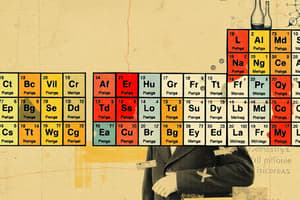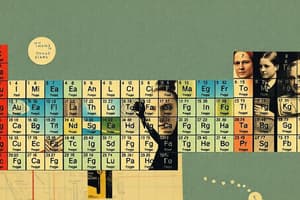Podcast
Questions and Answers
What significant discovery was made in 1800 regarding the elements?
What significant discovery was made in 1800 regarding the elements?
- Important connections in chemistry were revealed. (correct)
- The periodic table was established.
- The existence of new elements was confirmed.
- New compounds were created.
Which term best describes the scientific area focused on the study of elements?
Which term best describes the scientific area focused on the study of elements?
- Electromagnetism
- Physics
- Biochemistry
- Chemistry (correct)
Which element property was primarily determined through early experiments in 1800?
Which element property was primarily determined through early experiments in 1800?
- Physical state
- Chemical reactivity
- Electronegativity
- Atomic mass (correct)
Which one of the following processes does NOT relate to the discoveries made about elements in 1800?
Which one of the following processes does NOT relate to the discoveries made about elements in 1800?
What was a characteristic of the elements discovered during the period?
What was a characteristic of the elements discovered during the period?
What is a characteristic feature of noble gases?
What is a characteristic feature of noble gases?
Which of the following elements is classified as a noble gas?
Which of the following elements is classified as a noble gas?
Which element emits radiation as part of its nuclear properties?
Which element emits radiation as part of its nuclear properties?
What is the primary state of noble gases at room temperature?
What is the primary state of noble gases at room temperature?
Which of these properties does not apply to noble gases?
Which of these properties does not apply to noble gases?
Which noble gas is commonly used in lighting and signs?
Which noble gas is commonly used in lighting and signs?
What is one of the main health risks associated with radon exposure?
What is one of the main health risks associated with radon exposure?
Which noble gas is used in neon signs?
Which noble gas is used in neon signs?
What important concept about elements was revealed in the early 1800s?
What important concept about elements was revealed in the early 1800s?
Which two or more elements demonstrated similar qualities according to early studies?
Which two or more elements demonstrated similar qualities according to early studies?
What role did 1800s experiments play in the field of chemistry?
What role did 1800s experiments play in the field of chemistry?
Which property is least associated with elements discovered in the 1800s?
Which property is least associated with elements discovered in the 1800s?
What classification can be associated with the elements identified in early 1800s research?
What classification can be associated with the elements identified in early 1800s research?
Which element is known for emitting radiation due to its nuclear properties?
Which element is known for emitting radiation due to its nuclear properties?
Which of the following elements is NOT classified as a noble gas?
Which of the following elements is NOT classified as a noble gas?
What characteristic do noble gases share at room temperature?
What characteristic do noble gases share at room temperature?
What type of bonds do noble gases typically form?
What type of bonds do noble gases typically form?
Which noble gas is primarily associated with lighting applications?
Which noble gas is primarily associated with lighting applications?
How is radon primarily produced in the environment?
How is radon primarily produced in the environment?
What is a common health risk associated with radon exposure?
What is a common health risk associated with radon exposure?
Which statement is true about the elements present in the periodic table?
Which statement is true about the elements present in the periodic table?
Study Notes
Introduction to the Periodic Table
- Background: The periodic table is a systematic organization of all known chemical elements.
- Early Development: In the 1800s, scientists like Döbereiner, Newlands, and Mendeleev observed patterns in the properties of elements.
- Mendeleev's Contribution: Mendeleev's periodic table, published in 1869, arranged elements based on increasing atomic weight (later atomic number), highlighting recurring patterns of chemical properties.
Key Features and Organization
- Arrangement: Elements are organized by atomic number, with similar properties grouped together in vertical columns called groups (or families) and horizontal rows called periods.
- Periods: Elements in the same period have the same number of electron shells.
- Groups: Elements in the same group share similar chemical properties due to having the same number of valence electrons (electrons in the outermost shell).
Trends in the Periodic Table
- Electronegativity: A measure of an atom's attraction to electrons in a chemical bond. Electronegativity generally increases across a period (left to right) and decreases down a group (top to bottom).
- Ionization Energy: The energy required to remove one electron from an atom in its gaseous state. Ionization energy generally increases across a period and decreases down a group.
- Atomic Radius: The distance from the nucleus to the outermost electron shell. Atomic radius generally decreases across a period and increases down a group.
Classification of Elements
- Metals: Generally shiny, solid at room temperature, good conductors of heat and electricity, malleable (can be hammered into sheets), and ductile (can be drawn into wires).
- Nonmetals: Generally lack metallic properties, can be gases, liquids, or solids at room temperature, poor conductors of heat and electricity, brittle, and often colorful.
- Metalloids: Have properties of both metals and nonmetals, are semiconductors (conduct electricity under certain conditions).
Groups and Periods
- Group 1 (Alkali Metals): Very reactive metals, readily form +1 ions.
- Group 2 (Alkaline Earth Metals): Reactive metals that form +2 ions.
- Group 17 (Halogens): Very reactive nonmetals, readily form -1 ions.
- Group 18 (Noble Gases): Inert gases, often unreactive due to having a full outer shell of electrons.
Nuclear Chemistry
- Isotopes: Atoms of the same element with the same number of protons but different numbers of neutrons.
- Radioactivity: The spontaneous emission of particles and/or energy from the nucleus of an unstable atom.
- Radioactive Decay: Process by which unstable isotopes transform into stable isotopes.
Periodic Table: A Key Tool in Chemistry
- The periodic table is a fundamental tool in chemistry, enabling scientists to predict and understand the behavior of elements and their compounds.
- It serves as a framework for organizing vast chemical information and fostering scientific advancements.
Examples of Elements
- Hydrogen (H): The most abundant element in the universe.
- Oxygen (O): Essential for life, a major component of the atmosphere and water.
- Carbon (C): The basis of life, forms the backbone of organic molecules.
- Gold (Au): A precious metal, prized for its beauty and resistance to corrosion.
- Uranium (U): A radioactive element used in nuclear power generation.
Early Discoveries and Grouping
- Dobereiner's Triads: This concept grouped chemical elements together with similar chemical properties.
- Newlands' Law of Octaves : Newlands discovered that when elements were arranged in order of increasing atomic weight, every eighth element had similar properties.
- Mendeleev's Periodic Law: He arranged periodic elements into groups based on their atomic masses and similar chemical properties. He predicted the existence of undiscovered elements.
- Mendeleev's Contributions: Mendeleev’s work highlighted the importance of atomic weights and the periodicity of chemical properties.
Periodic Trends and Groups
- The Periodic Table: The periodic table arranges elements based on increasing atomic number.
- Periods and Groups : Elements in the same period have the same number of electron shells. Elements in the same group have the same number of valence electrons, which affects their chemical reactivity.
- Trends in the Periodic Table: These include electronegativity, ionization energy, and atomic radius.
Noble Gases
- The Noble Gases: These elements are found in Group 18 of the periodic table and are unreactive due to their stable electron configuration.
- Radon: Radon is a radioactive gas found in the earth’s crust and is derived from the radioactive decay of uranium.
Note -
- The original text uses unusual punctuation and capitalization, but some important information can be pulled from the text to write concise study notes.
- The text doesn’t cover all major concepts related to the periodic table; further research is recommended.
Studying That Suits You
Use AI to generate personalized quizzes and flashcards to suit your learning preferences.
Related Documents
Description
This quiz delves into the periodic table's history, organization, and key features. Learn about the contributions of early scientists, including Mendeleev, and explore how elements are arranged based on their properties. Test your knowledge on the trends within the periodic table.




